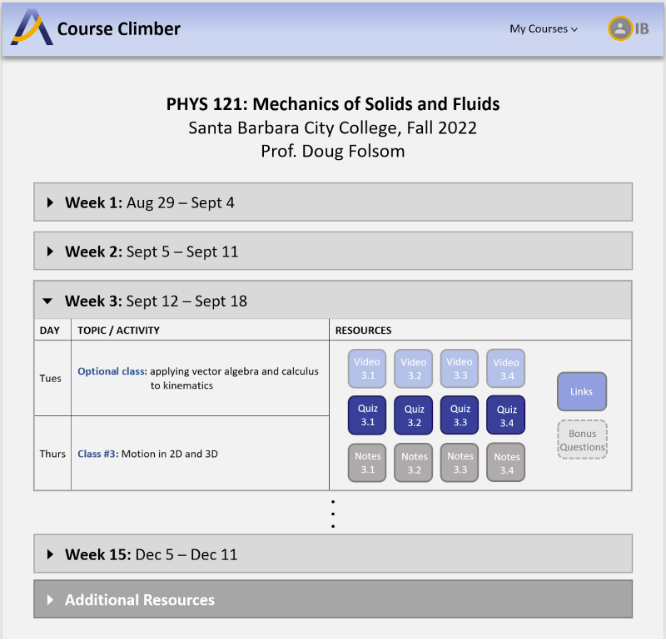Introduction
In a typical university science/engineering course, students learn the course material through a combination of :
Viewing/attending course lectures (which may be live or virtual and may be delivered synchronously or asynchronously)
Taking notes on material covered in the lecture to which they can then later refer
Assigned reading from a text that typically provides added depth and detail
Solving problems via homework assignments as well as during lecture and (at some institutions) discussion sections
Attending instructor/TA office hours
For a variety of reasons, many students find it difficult or lack the time to complete all of the material/activities outlined above. Additionally, jumping back and forth between these different modes of learning has been shown to be both difficult and intimidating for many students. For example, many first generation and URM college students feel intimidated by the idea of attending office hours or asking questions in class, and many students who support themselves by working while attending college often forgo reading the text since they lack the time to complete all of the course material and feel that this will have the least impact on their grade. Finally, instructors spend a large portion of their class time covering conceptual material instead of creating the kind of meaningful engagement that occurs with the subset of students who attend office hours.
One way to address some of these issues is through a flipped classroom approach, in which conceptual material is presented by way of video recordings that students watch outside of class, leaving time in class for problem solving and other interactive activities. Some of the challenges that many instructors in STEM fields have found with this approach include:
- Non-compliance with students in watching videos before class time (similar to non-compliance with reading assigned sections from text)
- The time burden for the students is greater than in a traditional classroom format, as there is now even more work that students must complete outside of class.
Course Climber Curriculum Overview
The Course Climber curriculum has been developed based on data-driven research in university engineering and physical sciences courses carried out over several years that was largely geared towards improving in-classroom student engagement. The key aspect of the curriculum is that the traditional lecture material, textbook, student notes, and example problems are combined into a single module that we call a “video book”. Our video books include 10-25 minute videos (typically 3-4 per week), combined with a set of note sheets that are displayed in the videos and are also separately provided to the students. The note sheets are designed to be easily readable in video format and also to provide the key material that would be obtained from a textbook, without being nearly as dense as the reading found in a textbook. Students watch the videos and simultaneously annotate over the note sheets. In this way, their annotated note sheets become both their course notes and their textbook in a single unit. At the completion of each video, students complete a short quiz question (typically 1-2 minutes to complete) to ensure that they understood the key concepts presented in the video.
By moving the content-acquisition phase to video books consumed asynchronously outside of class, synchronous class times in the Course Climber curriculum are substantially more interactive than in a traditional classroom format, and are largely spent on problem solving and student presentation activities. We provide instructors with example problems to go through during class time that are specifically designed to be paired with and to complement the video book content. In order to be successful with this form of instruction, and particularly to ensure that students complete their video book activities ahead of class time, it is important that the class time is organized in a fairly specific format, which we go over in our instructor intro sessions.
All video book material, as well as instructor resources and other supplemental material, are accessed via our web interface. The specific site we set up for your course includes all the material organized and accessible in a format that is simple and easy to follow. Instructors also have access to analytics indicating when students are completing the video book material and quizzes, making it easy to quickly identify students that may be falling behind.
Student Interface

Instructor Interface

Courses that have been run by instructors using this methodology have been found to result in dramatic improvements in exam scores across the entire spectrum of students (top of the class through bottom of the class) as compared to the same course previously taught by the same instructor in a traditional format. Instructors have reported spending less time on their courses while seeing a substantial improvement in student engagement, and surveys of students that learned via this methodology indicated that over 87% preferred this format to a traditional classroom format and would like to have more courses taught in this format.
Proven methodology and content lead to improved student learning outcomes without increasing the time spent on the course by students
Textbook, reading, lessons, and notetaking are all combined into one convenient video book
Less prep time for instructors, particularly those teaching a course for the first time
More time spent actively engaging students, particularly those that may be struggling
Greater opportunities for struggling students to receive the help they need
More time spent developing students’ problem solving and presentation skills
More opportunities to introduce exciting topics or areas of active research
Analytic tools allow instructors to quickly identify students that are falling behind
Holidays and unexpected absences by the instructor are much more easily accommodated
